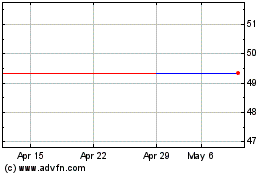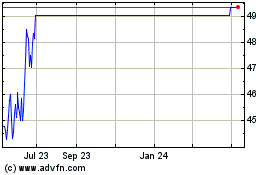DHL's Drone Demonstration Fails to Deliver
January 19 2016 - 1:33PM
Dow Jones News
By Hendrik Varnholt
PRIEN, Germany--High in the Bavarian Alps, package-delivery
giant DHL this week demonstrated the potential and pitfalls of
shipping with drones.
The unit of German postal company Deutsche Post AG on Monday
presented a new unmanned aerial vehicle capable of carrying up to
two kilograms, or almost 5 pounds, for several kilometers. DHL,
which already has used a drone to deliver medicine to a remote
North Sea island, convinced German authorities to close local
airspace for test flights and invited media to see the aircraft's
capabilities.
Then Deutsche Post scrubbed the proposed flight Tuesday, blaming
winter weather. The company had said its drone was perfectly suited
to use in mountain regions, where wind, cold and snow are frequent
concerns.
Despite the setback, Deutsche Post's board member Jürgen Gerdes
told a group of international journalists who had traveled to see
the flight that "the drone works."
He said that "in the not-so-distant future, drone deliveries
will no longer be a niche business" and the company would operate a
fleet of flying DHL drones.
Still, DHL's ability even to plan such a flight puts it far
ahead of U.S. companies, which are struggling to test commercial
drones under strict Federal Aviation Administration
restrictions.
DHL is also developing driverless delivery vans, Mr. Gerdes
said. "It's unbelievable how well that works," he said of the vans,
although the technology remains far from routine use, he added.
The German company's approach to drone delivery differs from
those of Amazon.com Inc. and Alphabet Inc.'s Google unit, which
have both talked up prospects of autonomous deliveries straight to
customers' doorsteps.
DHL aims to use drones for shipments to parcel lockers--like the
thousands of the company's existing Packstation delivery lockers.
Customers receive a personal code to open a specific locker once a
package has been delivered. By delivering parcels to pickup
facilities rather than recipients' homes, DHL aims to avoid
difficulties and the risk of collisions in landing at unfamiliar
locations.
DHL Senior Vice President Ole Nordhoff said the company's new
drone can autonomously place parcels inside a locker unit, through
a door in the top. The unit automatically sorts deliveries into
specific lockers.
"The locker station is packed with technology," he said.
DHL in 2014 conducted a three-month test in the North Sea using
helicopter-like drones. The company's newest unmanned aerial
vehicle is completely redesigned and more closely resembles an
airplane with propellers that tilt or the U.S. military's
tilt-rotor V-22 Osprey. The 12 kilogram aircraft has done test
flights of roughly 8 kilometers, climbing from a base at 700 meters
to a remote ski area 500 meters higher up.
The company opted for a tilt-wing design because it can take off
and land vertically like a helicopter and fly like an airplane.
"Tilt-wing drones are more energy efficient and can therefore
travel longer distances," said Dieter Moormann, a professor of
flight dynamics at Germany's University of Aachen, which was a
partner with DHL on the project.
In Germany and other countries, drone operators must keep
unmanned aircraft in visual sight, Prof. Moorman said. For DHL's
test flights, German aviation regulators closed local airspace. Mr.
Gerdes helped negotiate the exemption, he said.
In the U.S., a 2012 law exempts recreational drone use from most
restrictions, but the FAA has effectively banned commercial use of
the devices. The agency two years later started approving
commercial operations on a case-by-case basis. It has now
authorized more than 3,000 companies to operate drones in the U.S.
for uses including farming, filmmaking and aerial inspections of
pipelines and other remote locations. Only licensed pilots are
allowed to operate these companies' drones.
U.S. approval of some commercial-drone operations has relieved
some pent-up demand for such flights, but the drone industry is
still awaiting comprehensive commercial-drone rules that were
proposed in early 2014. The proposed rules prohibit drones from
carrying external payloads or flying over bystanders--conditions
that likely preclude drone deliveries, industry officials say.
In Germany, Deutsche Post's Mr. Gerdes said the company aimed to
begin wider business tests of drones in the next year or two. He
declined to disclose the company's investment in the project plans
for its rollout.
Jack Nicas contributed to this article.
Write to Hendrik Varnholt at hendrik.varnholt@wsj.com
(END) Dow Jones Newswires
January 19, 2016 13:18 ET (18:18 GMT)
Copyright (c) 2016 Dow Jones & Company, Inc.
Deutsche Post (PK) (USOTC:DPSGY)
Historical Stock Chart
From May 2024 to Jun 2024

Deutsche Post (PK) (USOTC:DPSGY)
Historical Stock Chart
From Jun 2023 to Jun 2024
